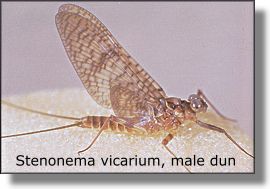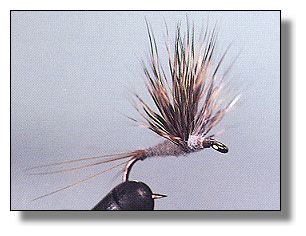Old Rupe is "off his feet" for a while, and we will fill in
for him the best we can. If you are knowledgeable about a particular
insect or local hatch, please help us out - contact:
LadyFisher.
Don't worry about photos, we have good references.

The March Brown and the Brown Drake are not the same thing. Well, not quite.
However in many parts of our country the names are used interchangeably.
You real bug-studying folks already know some of the names, such as;
Stenonema fuscum, Stenonema vicarium, Stenonema ithica, Ephemera simulans,
and it seems, tooti-fruiti. So much for all the techno-speak.
There are some things these insects do have in common. They are kind of brown, sort of.
Some are a bit cream, others on the yellow side. Still they fall under the 'March Brown-Brown
Drake' moniker. Most of them are about the same size, that is ten to sixteen, have darkish
wings in the dun stage and most hatch about the same time of year, pretty much. If you need
more specific information than that it is available in many books on the subject. A few even
come close to agreeing with each other. Most will forecast emergence from about May
twentieth through the end of June, give or take a week either way.
 You may find these hatching from late afternoon into dusk and the spinner fall near dark.
You will find each operating in slightly different types of water. Don't worry, just pay real
close attention to the flies in the air, on the surface and any nymphs you can find. A clue
could be to check under a few rocks before you get into the stream, you might be able to
tell what is probable. Look for nymphs with a tell-tale split type mark between the wing
pads. (Hint,* If any are going to hatch that evening, the split will be very prominent and
the wing pads will be enlarged and developed.)
You may find these hatching from late afternoon into dusk and the spinner fall near dark.
You will find each operating in slightly different types of water. Don't worry, just pay real
close attention to the flies in the air, on the surface and any nymphs you can find. A clue
could be to check under a few rocks before you get into the stream, you might be able to
tell what is probable. Look for nymphs with a tell-tale split type mark between the wing
pads. (Hint,* If any are going to hatch that evening, the split will be very prominent and
the wing pads will be enlarged and developed.)

This is probably an over simplification. The March Brown is really the large insect, the
Ephemera simulans, ( Matching The Hatch, page 50, but is
sometimes called the Brown Drake ). However according to another book (Hatches II,
page 160) the March Brown is the Stenonema vicarium. Different ideas,
different places. Sometimes the name Ginger Quill is used for the same insect.
The Brown Drake is the name sometimes used for the smaller fly, or group of flies. The
necessary thing for you to do is inquire about your local streams. Find out just what you
have and when it is likely to come off.
 Remember, the time of year is early summer and the color of your insects starts to
change from the blueish-sulphur shade to a darker one. The wings will be speckled
and darker, be prepared with a few duns, darker ones, size ten thru sixteen. Have
a few spinners with the same features. There are a few exceptions on one end, that
would be flies like the light Cahill which represents several smaller mayflies.
Remember, the time of year is early summer and the color of your insects starts to
change from the blueish-sulphur shade to a darker one. The wings will be speckled
and darker, be prepared with a few duns, darker ones, size ten thru sixteen. Have
a few spinners with the same features. There are a few exceptions on one end, that
would be flies like the light Cahill which represents several smaller mayflies.

The nymphs are different for the two flies also, one being short, wide and strong. The
other longer and narrower. Simple, have a few of both with you. Both are on the dark
speckled side. For tied imitations E. Schwiebert likes the American March Brown, by
Preston Jennings for the dun. For the spinner, the Great Red Spinner, by Charles Wetzel.
Al Caucci prefers his hackled comparadun for the dun and the compara-spinner for
the spent fly.

I usually do not get too uptight about this hatch and spinner fall and have found under
most conditions a fly which comes close in size and hue will do the job. These pictures
should give you some idea of what you are in for. Observation is your best bet when
fishing these flies. ~ JC
For more on mayflies check these out:
Photo credits: All photos from Hatches II
by Al Caucci & Bob Nastasi, published by Lyons Press.
|





